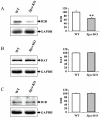Alteration of striatal dopaminergic neurotransmission in a mouse model of DYT11 myoclonus-dystonia
- PMID: 22438980
- PMCID: PMC3306281
- DOI: 10.1371/journal.pone.0033669
Alteration of striatal dopaminergic neurotransmission in a mouse model of DYT11 myoclonus-dystonia
Abstract
Background: DYT11 myoclonus-dystonia (M-D) syndrome is a neurological movement disorder characterized by myoclonic jerks and dystonic postures or movement that can be alleviated by alcohol. It is caused by mutations in SGCE encoding ε-sarcoglycan (ε-SG); the mouse homolog of this gene is Sgce. Paternally-inherited Sgce heterozygous knockout (Sgce KO) mice exhibit myoclonus, motor impairment and anxiety- and depression-like behaviors, modeling several clinical symptoms observed in DYT11 M-D patients. The behavioral deficits are accompanied by abnormally high levels of dopamine and its metabolites in the striatum of Sgce KO mice. Neuroimaging studies of DYT11 M-D patients show reduced dopamine D2 receptor (D2R) availability, although the possibility of increased endogenous dopamine, and consequently, competitive D2R occupancy cannot be ruled out.
Methodology/principal findings: The protein levels of striatal D2R, dopamine transporter (DAT), and dopamine D1 receptor (D1R) in Sgce KO mice were analyzed by Western blot. The striatal dopamine release after amphetamine injection in Sgce KO mice were analyzed by microdialysis in vivo. The striatal D2R was significantly decreased in Sgce KO mice without altering DAT and D1R. Sgce KO mice also exhibited a significant increase of dopamine release after amphetamine injection in comparison to wild-type (WT) littermates.
Conclusion/significance: The results suggest ε-SG may have a role in the regulation of D2R expression. The loss of ε-SG results in decreased striatal D2R, and subsequently leads to increased discharge of dopamine which could contribute to the behavioral impairment observed in DYT11 dystonia patients and in Sgce KO mice. The results suggest that reduction of striatal D2R and enhanced striatal dopamine release may contribute to the pathophysiology of DYT11 M-D patients.
Conflict of interest statement
Figures


References
-
- Fahn S. Concept and classification of dystonia. Adv Neurol. 1988;50:1–8. - PubMed
-
- Zimprich A, Grabowski M, Asmus F, Naumann M, Berg D, et al. Mutations in the gene encoding epsilon-sarcoglycan cause myoclonus-dystonia syndrome. Nat Genet. 2001;29:66–69. - PubMed
-
- Doheny DO, Brin MF, Morrison CE, Smith CJ, Walker RH, et al. Phenotypic features of myoclonus-dystonia in three kindreds. Neurology. 2002;59:1187–1196. - PubMed
-
- Misbahuddin A, Placzek M, Lennox G, Taanman JW, Warner TT. Myoclonus-dystonia syndrome with severe depression is caused by an exon-skipping mutation in the epsilon-sarcoglycan gene. Mov Disord. 2007;22:1173–1175. - PubMed
Publication types
MeSH terms
Substances
Supplementary concepts
Grants and funding
- NS37409/NS/NINDS NIH HHS/United States
- P30 NS057098/NS/NINDS NIH HHS/United States
- NS47692/NS/NINDS NIH HHS/United States
- NS65273/NS/NINDS NIH HHS/United States
- R21 NS065273/NS/NINDS NIH HHS/United States
- NS74423/NS/NINDS NIH HHS/United States
- R21 NS047692/NS/NINDS NIH HHS/United States
- NS47466/NS/NINDS NIH HHS/United States
- P01 NS037409/NS/NINDS NIH HHS/United States
- R21 NS072872/NS/NINDS NIH HHS/United States
- P30 NS047466/NS/NINDS NIH HHS/United States
- P50 NS037409/NS/NINDS NIH HHS/United States
- NS54246/NS/NINDS NIH HHS/United States
- R03 NS074423/NS/NINDS NIH HHS/United States
- NS57098/NS/NINDS NIH HHS/United States
- R01 NS054246/NS/NINDS NIH HHS/United States
- NS72872/NS/NINDS NIH HHS/United States
LinkOut - more resources
Full Text Sources
Research Materials

